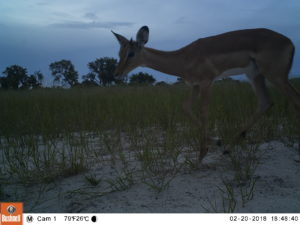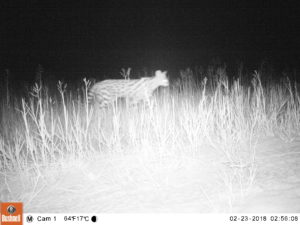by Anna Yu, of Colby College
Dumela bo mma le bo rra! Greetings from Maun! We finished our first adventure in the field on March 4th and returned to Maun for a short stop before carrying on the journey to Xai Xai. The 20 days in the bush marked tremendous excitements and unexpectedness, as we embraced the vivid culture and witnessed the astonishing wildlife in Khwai. During our stay in NG18 (Khwai private concession), we set up camera traps around Tau Camp to record the arrival of any “unexpected guests,” which ended up being one of the most rewarding highlights.
Camera trap is a common field method used in conservation science research. It is especially widely applied to carnivore density and demography studies due to safety and accessibility concerns. In a typical survey, researchers will set up cameras in the desired area on pre-existing objects in the environment, like trees or poles. These cameras are specially designed to be sensitive and capable of capturing subtle movements. Food and aromatic lures are often used to attract more individuals and gain a more comprehensive picture of species demography. The amount and distribution of camera traps are usually designed according to the objective species’ home range size to reduce repetitive counting. Researchers will also set a “photographic event” time on cameras so that the captures within a certain amount of time will be considered as the same individual. One drawback of this method, however, is that setting up all cameras in a relatively large survey area can be extremely costly regarding both expenses and efforts.
The goal of our camera trap practice in NG18 was to record what wildlife species came across or passed by our campsite. Therefore, we only set up three cameras with less consideration on the characteristics of specific species. Emmali Cabral from the University of Vermont, Paige Mathison from Westminster College, and I chose to set our camera at about 30m northwest to the Tau Camp. We believed that the open grassland and small herds of mopane (Colophospermum mopane) trees to the north of the campsite could be an ideal foraging area for herbivores and hoped that the hypothetical abundance of herbivore species could potentially attract carnivores as well. We tied the camera on a pole at 80cm high, aiming to capture large herbivores and large cats. We set our photographic event time to be 10 seconds, which meant the camera would pause for 10 seconds after each capturing to minimize replication. Finally, we adjusted the camera angle to face northwest to avoid blinding from sunrise and sunset.
We activated our camera trap at 16:53 on Feb.20 and turned it off at around 14:00 on Feb.23. Although we tried to pick a clear area with less grass in from of the lens to minimize distraction, the camera still captured more than 1700 irrelevant grass movement pictures. Among the 30 sufficient photographs, we found a herd of impalas (Aepyceros melampus) foraging around soon after we set up the camera on Feb.20. The herd consisted of at least four adult females and one juvenile male, which can be identified by their body sizes and horn shapes (Fig.1). Time, date, and temperature of each photographic event are shown on the bottom of the picture. Later at night, we also captured a springhare (Pedetes capensis) jumping across the grass. The most exciting finding was a solitarily wandering serval (Leptailurus serval). Before we turned on the camera, Emmali noticed a scat 3m southwest to the pole. Our instructor Samara helped us briefly analyze the composition of the scat and found bird and fruit remnant in it. Based on the shape and components, we inferred that the scat belonged to a medium sized carnivore species. It was such a rewarding moment to find our guess being confirmed by the capture. Look at the beautiful spots on its body and the adorable and short tail (Fig.2)! The camera trap experience in NG18 not only allowed us to practice new field methods that we learned in class, but also helped to reveal the mysteries of nature around us. Even after four weeks in the delta, I still feel like dreaming when embracing the sunshine on the endless South African savannah and falling asleep with the footsteps and whisperings of wildlife. I full-heartedly look forward to our next adventure in Xai Xai. I wonder which animals will come to visit us next time?

